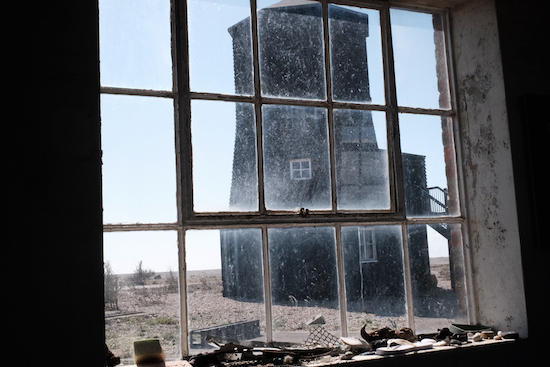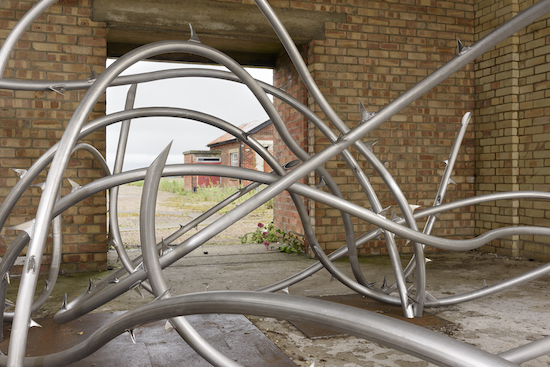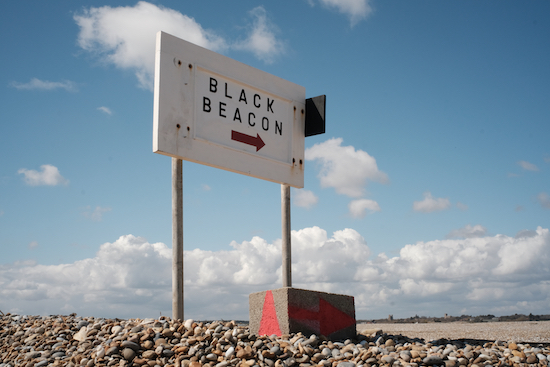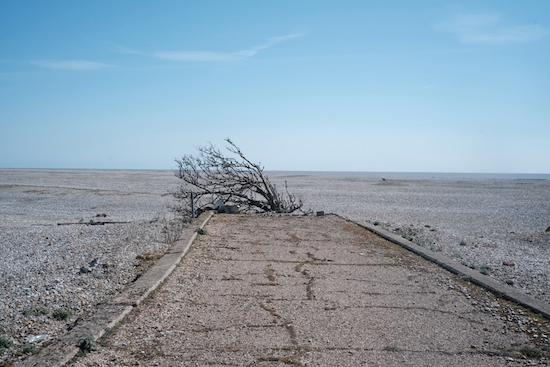A wind-swept tree blocking a path on the shingle on Orford Ness, April 2021. Commissioned and produced by Artangel. Presented in partnership with the National Trust. Photograph: Johny Pitts
Afterness, a series of new artworks on and inspired by Orford Ness, is, sorry to say, no match for the ten-mile shingle spit of land off the Suffolk coast from which the exhibition takes its name. This is not to belittle the five works installed there but to emphasise the singular magnificence of the Ness.
Once a military test site for communications and weapons systems during the Cold War, Orford Ness is dotted with abandoned structures in various states of dilapidation. It’s a National Trust site, deservedly recognised as an Area of Outstanding Natural Beauty, and it is through these extraordinary surroundings that the work of five artists must attempt to shine. Set out as a three-hour trail across the salt marshes and shingle coast, the exhibition invites the viewer to become a lone adventurer across a landscape that could be straight out of a science fiction novel and several of the works embrace this idea.
Alice Channer’s Lethality and Vulnerability (2021), a large aluminium sculpture resembling thorny brambles, is exhibited in a disused bomb shelter. Its metallic sheen highlights the unnaturalness of the form in contrast to its organic inspiration which are described in the exhibition notes as “nature’s equivalent to barbed wire – designed to protect and deter.” Channer’s sculpture looks like an experiment gone haywire, the twisted result of an attempt to play God. Its thorns and sharp edges at the end of twisting curves seeps a hostility and a sense of violence that reminds the visitor that research into atomic weapons once took place here.
In Lab 1, Paris-based visual artist Tatiana Trouvé’s The Residents (2021) seems a little less obtrusive than Channer’s work but no less unsettling, evocative of a post-apocalyptic scene. Dirty clothes hang on sculptures that look like totems; vintage suitcases, a radio and blankets with intricate geometric designs are strewn on the ground which is partially submerged. The work invites the visitor to imagine the disastrous circumstances (climate change-related, war-related?) that forced the former inhabitants of this settlement to flee.

Commissioned and produced by Artangel. Presented in partnership with the National Trust. Photograph: Johny Pitts
While the desolation of Orford Ness with its stark and mostly empty landscape and Cold War history serves as inspiration for the visual artists, the sound artists featured in the exhibition explore the atmospheric potential of the surroundings. One of the most striking structures is the Black Beacon, which, as its name suggests, is a black wooden former secret military navigation building with 360-degree views of the Ness. It has been adapted into the Library of Sound, holding a series of archival field recordings made around the Ness by sound artist and composer Iain Chambers with sound recordist and co-founder of Cabaret Voltaire, Chris Watson. DJ and producer Brian d’Souza (also known as Auntie Flo) has also created an “online companion” to the sound with beacon.black, a 24-hour radio show that streams field recordings and surveillance style footage of the Ness.
Climbing up a dusty staircase takes you to the top of the beacon where you can take a seat and look out for kilometres in any direction while sounds ranging from the jangling of keys to crashing waves at the shore play. But the effect is diminished by poor acoustics. The audio of howling wind manages to add a bit of an atmosphere, aided by views of the sea, but less complex sounds, like a door closing, are overwhelmed by even the lowest of voices. The spell is too easily broken.

Commissioned and produced by Artangel. Presented in partnership with the National Trust. Photograph: Thierry B
Conflicting sounds is a common theme across the works. At the information centre at the start of the trail, visitors are given a headset and a mini mp3 player which contains a playlist of soundscapes and renditions of the poems from the Ukrainian-born, US-based poet Ilya Kaminsky’s contribution to the exhibition, I See a Silence (2021). The audio playlist has been designed so that the visitor can listen to certain parts at different locations. The first poem, ‘Arrival’ is located on the roof of the appropriately and violently alliterative Bomb Ballistics building – an ugly, peeling, square thing – and is performed by Kaminsky himself. The deaf poet’s booming and sonorous voice is impressive and powerful enough to cut through the sound of the wind. But continuing the trail towards the shore, Axel Katacouié’s bespoke soundscape of birdsong and waves clashes with the sound of the wind around your own ears and the crunching of your own shoes on the shingle. The audio is supposed to accompany the visitor around the trail, but it is most effectively heard when standing still in one place, less distracted by the fascinating topography of the Ness – if that is even possible.
Kaminsky’s lyric, a mix of prose and poetry, moves from the solemn and philosophical to the irreverent and back. It is a boon that the complete book of poems is available as it is one of the exhibition’s strongest aspects. I See a Silence sees different speakers attempt to interrogate their own presence at Orford Ness and the sense of both wonder and isolation that it invokes, an effective mirror of thoughts a visitor might have too. “Be careful of the wind at Ness,” he writes in one poem. “If you don’t have clarity, find it / on a shingle spit” he writes in another.

Commissioned and produced by Artangel. Presented in partnership with the National Trust. Photograph: Johny Pitts
Afterness is an experience that fires the imagination, but that is predominantly because Orford Ness is so extraordinary. Here the ubiquitous presence of history and the strange beauty of the natural landscape turns your mind to its own preservation and survival. The National Trust is allowing most of the structures to decay naturally. However, in September 2020, the old red and white Orford Ness Lighthouse had to be demolished for fears the ongoing coastal erosion would cause the structure to fall into the sea, permanently changing the morphology of the coastline. A pile of rubble stands where the lighthouse once did. The artworks, transportive to varying degrees – whether that’s to a drowned future world or the nuclear anxiety of the past – work more effectively to emphasise the worthiness of Orford Ness than as extraordinary works in themselves.
Artangel presents Afterness at Orford Ness, Woodbridge, Suffolk, until 30 October 2021


